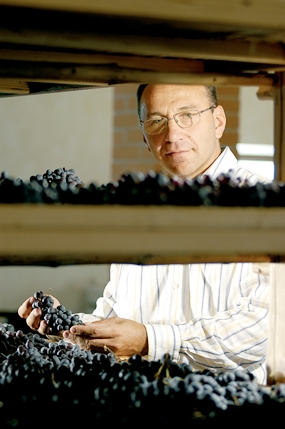Ask any experienced wine drinkers to name a well-known Italian white wine, and they’ll probably come up with Soave or Frascati. There are others of course, including Orvieto but possibly the sheer volume of Soave (SWAH-vay) pouring out of the Veneto region in recent decades has drowned out the competition. Soave’s naturally refreshing appeal brought it enormous popularity in the second half of the 20th century.
This was the time when an enormous amount of Soave flooded into the US and UK markets. Pleasant enough stuff it was too, but little fruit to speak of and sometimes not much more taste than water. Still, it could be a delightfully refreshing cold drink for a summer’s evening and fun to drink with an alfresco pizza or sea food. It came to epitomize the typical popular Italian white.
At its best, Soave is light and dry, fresh and smooth. It’s never aged and invariably best when young. The wine laws governing Soave state that it must be made primarily from Garganega grapes, which grow on the hillsides east of Verona, in the Veneto wine region of north-eastern Italy. The regulations state only Chardonnay and Trebbiano di Soave may be blended with the Garganega.
Domìni Veneti Soave Classico 2010 (white) Italy. (Best Supermarket, Bt. 630)
The word “Classico” on the label means that the grapes are from wines the traditional vineyard zone. That’s where the best grapes come from. This wine is made by the respected wine company Cantina Valpolicella Negrar, a co-operative located just a few kilometres from Verona.
 Daniele Accordini, Oenologist and General Director, Cantina Valpolicella Negrar.
Daniele Accordini, Oenologist and General Director, Cantina Valpolicella Negrar.
The wine is a light straw yellow with a delicate floral, buttery aroma of white fruit that reminds me slightly of a crisp Chardonnay. Matured in stainless steel vats for four months, it’s dry, medium-bodied and fresh, with a good balance of fruit, giving the taste a pleasing softness. You might also pick up faint hints of almond from the Garganega in the blend. There’s a decently long finish too. The fruity taste is far removed from the bland Soave wines of yesteryear and it really seems as though the producers have done their best to shake off Soave’s earlier reputation for blandness. And I think they have succeeded too, though you’d be forgiven for mistaking this wine for something else.
The wine is just over 12% alcohol and I tasted it at 12°C, then decided to try it at 5°C, normally considered too low for a white wine. But it worked, because the low temperature really brought out the lovely freshness. It just goes to show, if you want to bring out the best in a wine, get the temperature right. The Taylor digital thermometers (Bt. 650 at Villa) are excellent for both wine and food. The latest models have a button to switch between Celsius and Fahrenheit.
Villa dei Tigli Valpolicella 2010 (red) Italy. (Best Supermarket, Bt. 530)
The hillsides of Verona are not only the home of Soave grapes. Valpolicella, the most important red wine of the Veneto, comes from the same region too. The oldest traces of vine cultivation there date back to the 5th century B.C. and evidently the Emperor Augustus preferred Veneto reds to anything else. Valpolicella (vahl-paw-lee-CHEHL-lah) is usually made from a blend of Corvina, Veronese, Rondinella and Molinara grapes but the wine laws allow for others too. These wines are full, fruity and velvety on the palate with an attractive aftertaste. They also tend to be less tannic than many other Italian reds.
This is a fairly typical Valpolicella, with a pleasing intense ruby-red appearance and an aroma of canned strawberries, vanilla, oak and herbs. For some reason, the wine also reminded me of the smell of nettles, although I have never been foolhardy enough to try smelling one. It’s quite full-bodied with a pleasant taste of tart cherries and a nice touch of tannin. It’s perfectly dry too, with good fruit on the palate and a long dry finish. Crisp and refreshing at just 11% alcohol, this wine would be perfect with pizza. Here of course, I refer to the traditional thin-based Italian pizza, not some of the pizza-like abominations that you sometimes find in this neck of the woods.




